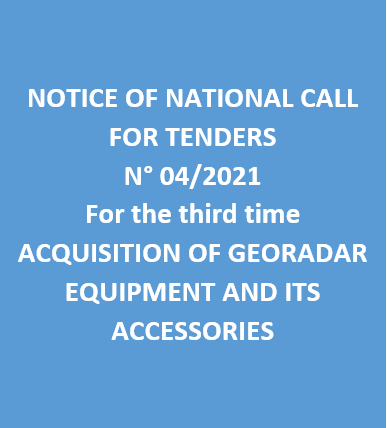| Annual program and technical progress report |
-

Activity Report 2023
-

Technical Program 2024
|
| Geocatalogue |

|
| Invitation to
tender |
-

REALIZATION OF THE TRAINING PLAN FOR THE YEAR 2022
-

ACQUISITION OF TWO SERVICE CARS
-

ACQUISITION OF GEORADAR EQUIPMENT AND ITS ACCESSORIES
|
|
Invest in Tunisia |

|
|
|
|
|
::
Documentation and Editions
>>
Research library
|
| |
|
[
Search by author
]
[
Search keyword
]
[
Search by index
]
[
Search by category
]
|
title of the reference :
|
Burial dolomitization of organic-rich and organic-poor carbonates, Jurassic of Central Tunisia.
|
|
Publication Date:
|
1994
|
|
Author :
|
Soussi Mohamed, M'rabet Ali
|
|
Catalogue type :
|
Livre
|
|
Catalogue reference :
|
Vol.21 Spec. Publs Int. Ass. Sedimentol. Vol.21 Burial dolomitization of organic-rich and organic-poor carbonates, Jurassic of Central Tunisia. Sedimentological, isotopic, geochemical and fluid-inclusion studies of Jurassic organic-poor carbonates from the Nara Formation in Central Tunisia have led to definition of three groups of dolomites. The Lower Nara dolomites (Liassic)correspond to peritidal and bioclastic deposits: they are depleted in heavy oxygen and improverished in strontium (30 ppm)and contain fluid inclusions whose temperature of homogenization has reached 120°C. The Middle Nara dolomites (Toarcien)are organic-rich, ferroan and relatively and enriched in strontium (110 ppm): they have light oxygen and carbon isotopic signatures. 13C values which negatively correlate with TOC indicate that part of the carbon was derived from organic matter, either during early bacterial reduction of sulphates or later during deep thermal decarboxylation. The Upper Nara dolomites (Malm)correspond to hemipelagic carbonates and are impoverished in 18O and Sr (60 ppm). These Nara dolomites formed in the subsurface, during shallow to deep burial and under increasing temperatures. Dolomitizing fluids seem to have been multiple in origin and include interstitial (connate)seawater, waters expelled from neighbouring shales and upling-flowing basinal marine water. Dolomitization and associated recrystallization strarted during the Lower Cretaceous, and were competed by the end of the Upper Cretaceous. The massive dolomites have been affected by post-Cretaceous fractures, the latter having been cemented by hydrothermal saddle dolomite. This study confirms that aggradational burial dolomitization by warm and saline waters can be an important process in dolomite genesis, and that organic matter may be an active controlling factor of dolomitization in anoxic environments. bibliogr. enfouissement ; dolomitisation ; carbonate ; Jurassique ; formation Nara ; Tunisie ; Tunisie Centrale ; J. Rhéouis ; J. Sidi Khalif ; J. Chaabet el Attaris ; J. Nara ; J. el Haouareb ; J. Loridja M'rabet Ali Soussi Mohamed Roches Sédmentaires, Sédimentologie
|
|
Indexation decimale :
|
Roches Sédmentaires, Sédimentologie
|
|
Keywords :
|
enfouissement ; dolomitisation ; carbonate ; Jurassique ; formation Nara ; Tunisie ; Tunisie Centrale ; J. Rhéouis ; J. Sidi Khalif ; J. Chaabet el Attaris ; J. Nara ; J. el Haouareb ; J. Loridja
|
|
Summary :
|
Sedimentological, isotopic, geochemical and fluid-inclusion studies of Jurassic organic-poor carbonates from the Nara Formation in Central Tunisia have led to definition of three groups of dolomites. The Lower Nara dolomites (Liassic)correspond to peritidal and bioclastic deposits: they are depleted in heavy oxygen and improverished in strontium (30 ppm)and contain fluid inclusions whose temperature of homogenization has reached 120°C. The Middle Nara dolomites (Toarcien)are organic-rich, ferroan and relatively and enriched in strontium (110 ppm): they have light oxygen and carbon isotopic signatures. 13C values which negatively correlate with TOC indicate that part of the carbon was derived from organic matter, either during early bacterial reduction of sulphates or later during deep thermal decarboxylation. The Upper Nara dolomites (Malm)correspond to hemipelagic carbonates and are impoverished in 18O and Sr (60 ppm). These Nara dolomites formed in the subsurface, during shallow to deep burial and under increasing temperatures. Dolomitizing fluids seem to have been multiple in origin and include interstitial (connate)seawater, waters expelled from neighbouring shales and upling-flowing basinal marine water. Dolomitization and associated recrystallization strarted during the Lower Cretaceous, and were competed by the end of the Upper Cretaceous. The massive dolomites have been affected by post-Cretaceous fractures, the latter having been cemented by hydrothermal saddle dolomite. This study confirms that aggradational burial dolomitization by warm and saline waters can be an important process in dolomite genesis, and that organic matter may be an active controlling factor of dolomitization in anoxic environments.
|
|
Exemplaries :
|
TU1808C, TU1808B, TU1808A
|
|
|
|
|
|
|
|



